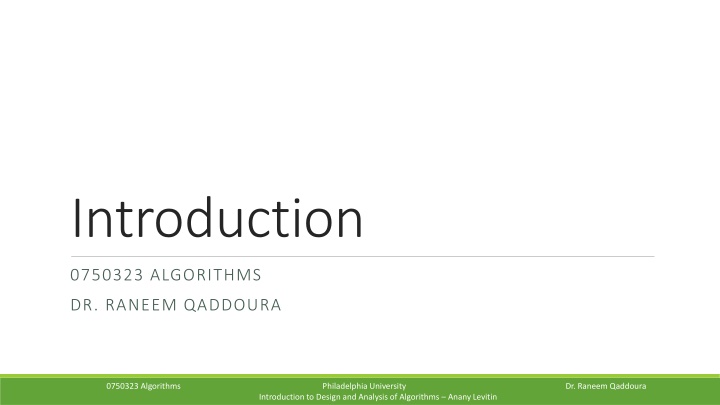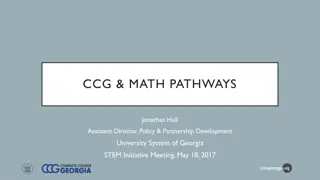
Exploring Algorithms: Introduction, Types, and Examples
Understanding algorithms is crucial in the field of computer science. This content delves into the definition of algorithms, important problem types, and examples like sorting and searching. It discusses the variability of algorithms and their efficiency based on different scenarios, highlighting the complexity of selecting the most suitable algorithm for specific situations.
Download Presentation

Please find below an Image/Link to download the presentation.
The content on the website is provided AS IS for your information and personal use only. It may not be sold, licensed, or shared on other websites without obtaining consent from the author. If you encounter any issues during the download, it is possible that the publisher has removed the file from their server.
You are allowed to download the files provided on this website for personal or commercial use, subject to the condition that they are used lawfully. All files are the property of their respective owners.
The content on the website is provided AS IS for your information and personal use only. It may not be sold, licensed, or shared on other websites without obtaining consent from the author.
E N D
Presentation Transcript
Introduction 0750323 ALGORITHMS DR. RANEEM QADDOURA 0750323 Algorithms Philadelphia University Dr. Raneem Qaddoura Introduction to Design and Analysis of Algorithms Anany Levitin
What is an algorithm? An algorithm is a sequence of unambiguous instructions for solving a problem, i.e., for obtaining a required output for any legitimate input in a finite amount of time. 0750323 Algorithms Philadelphia University Dr. Raneem Qaddoura Introduction to Design and Analysis of Algorithms Anany Levitin
Important problem types Sorting Searching String processing Graph problems Geometric problems Numerical problems 0750323 Algorithms Philadelphia University Dr. Raneem Qaddoura Introduction to Design and Analysis of Algorithms Anany Levitin
Example of computational problem: sorting Statement of problem: Input: A sequence of n numbers < a1, a2, , an > Output: A reordering of the input sequence sequence <a 1, a 2, , a n> so that a i a jwhenever i < j Instance: The sequence <5, 3, 2, 8, 3> Algorithms: Selection sort Insertion sort Merge sort (many others) 0750323 Algorithms Philadelphia University Dr. Raneem Qaddoura Introduction to Design and Analysis of Algorithms Anany Levitin
Selection Sort Input: array a[1], , a[n] Output: array a sorted in non-decreasing order Algorithm: for i=1 to n swap a[i] with smallest of a[i], a[n] 0750323 Algorithms Philadelphia University Dr. Raneem Qaddoura Introduction to Design and Analysis of Algorithms Anany Levitin
No single algorithm fits all situations best! Sorting Some of the algorithms are simple but relatively slow, while others are faster but more complex Some work better on randomly ordered inputs, while others do better on almost-sorted lists Some are suitable only for lists residing in the fast memory, while others can be adapted for sorting large files stored on a disk Searching Some algorithms work faster than others but require more memory Some are very fast but applicable only to sorted arrays In applications where the underlying data may change frequently relative to the number of searches, searching has to be considered in conjunction with two other operations: an addition to and deletion from the data set of an item. Organizing very large data sets for efficient searching poses special challenges with important implications for real-world applications. 0750323 Algorithms Philadelphia University Dr. Raneem Qaddoura Introduction to Design and Analysis of Algorithms Anany Levitin
Algorithm design and analysis process Understand the problem Decide on: computational means, exact vs. approximate solving, algorithm design technique Design an algorithm (Natural language, pseudocode, flowchart) Prove correctness Analyze the algorithm and data structure Efficiency (time & space) Simplicity Generality Code the algorithm 0750323 Algorithms Philadelphia University Dr. Raneem Qaddoura Introduction to Design and Analysis of Algorithms Anany Levitin
Algorithm design strategies Brute force Greedy approach Divide and conquer Dynamic programming Decrease and conquer Backtracking and branch-and-bound Transform and conquer 0750323 Algorithms Philadelphia University Dr. Raneem Qaddoura Introduction to Design and Analysis of Algorithms Anany Levitin
Why need algorithm analysis? Writing a working program is not good enough The program may be inefficient! If the program is run on a large data set, then the running time becomes an issue 0750323 Algorithms Philadelphia University Dr. Raneem Qaddoura Introduction to Design and Analysis of Algorithms Anany Levitin
Fundamental Data structures A data structure can be defined as a particular scheme of organizing related data items. The nature of the data can range from data types (e.g., integers or characters) to data structures (e.g., one-dimensional array) Data Structures Lists (array, string, linked list, stack, queue) Graphs Trees Sets 0750323 Algorithms Philadelphia University Dr. Raneem Qaddoura Introduction to Design and Analysis of Algorithms Anany Levitin
Linear Data Structures A linear list or simply a list is a finite sequence of data items, i.e., a collection of data items arranged in a certain linear order A (one-dimensional) array is a sequence of n items of the same data type that are stored contiguously in computer memory and made accessible by specifying a value of the array s index A string is a sequence of characters from an alphabet terminated by a special character indicating the string s end. A linked list is a sequence of zero or more elements called nodes, each containing two kinds of information: some data and one or more links called pointers to other nodes of the linked list. Singly linked list Doubly linked list 0750323 Algorithms Philadelphia University Dr. Raneem Qaddoura Introduction to Design and Analysis of Algorithms Anany Levitin
Linear Data Structures A linear list or simply a list is a finite sequence of data items, i.e., a collection of data items arranged in a certain linear order A stack is a list in which insertions and deletions can be done only at the end (top) last-in first-out (LIFO) A queue is a list from which elements are deleted from one end of the structure, called the front, and new elements are added to the other end (rear) first-in first-out (FIFO) 0750323 Algorithms Philadelphia University Dr. Raneem Qaddoura Introduction to Design and Analysis of Algorithms Anany Levitin
Graphs A graph is informally thought of as a collection of points in the plane called vertices or nodes, some of them connected by line segments called edges or arcs. Formally, a graph G = V,E is defined by a pair of two sets: a finite nonempty set V of items called vertices and a set E of pairs of these items called edges. Undirected vs directed graphs Complete graph Connected graph Dense vs sparse graphs 0750323 Algorithms Philadelphia University Dr. Raneem Qaddoura Introduction to Design and Analysis of Algorithms Anany Levitin
Graphs Representations The adjacency matrix of a graph with n vertices is an n n boolean matrix with one row and one column for each of the graph s vertices, in which the element in the ith row and the jth column is equal to 1 if there is an edge from the ith vertex to the jth vertex, and equal to 0 if there is no such edge. The adjacency lists of a graph or a digraph is a collection of linked lists, one for each vertex, that contain all the vertices adjacent to the list s vertex (i.e., all the vertices connected to it by an edge). 0750323 Algorithms Philadelphia University Dr. Raneem Qaddoura Introduction to Design and Analysis of Algorithms Anany Levitin
Graphs A weighted graph (or weighted digraph) is a graph (or digraph) with numbers assigned to its edges. These numbers are called weights or costs. An interest in such graphs is motivated by numerous real- world applications, such as finding the shortest path between two points in a transportation or communication network or the traveling salesman problem. 0750323 Algorithms Philadelphia University Dr. Raneem Qaddoura Introduction to Design and Analysis of Algorithms Anany Levitin
Trees A tree (more accurately, a free tree) is a connected acyclic graph A graph with no cycles is said to be acyclic A graph that has no cycles but is not necessarily connected is called a forest: each of its connected components is a tree For every two vertices in a tree, there always exists exactly one simple path from one of these vertices to the other. Select an arbitrary vertex in a free tree and consider it as the root of the so-called rooted tree. 0750323 Algorithms Philadelphia University Dr. Raneem Qaddoura Introduction to Design and Analysis of Algorithms Anany Levitin
Trees Ordered Trees An ordered tree is a rooted tree in which all the children of each vertex are ordered. It is convenient to assume that in a tree s diagram, all the children are ordered left to right. A binary tree can be defined as an ordered tree in which every vertex has no more than two children and each child is designated as either a left child or a right child of its parent; a binary tree may also be empty. A number assigned to each parental vertex is larger than all the numbers in its left subtree and smaller than all the numbers in its right subtree. Such trees are called binary search trees. 0750323 Algorithms Philadelphia University Dr. Raneem Qaddoura Introduction to Design and Analysis of Algorithms Anany Levitin
Sets In mathematic, a set can be described as an unordered collection (possibly empty) of distinct items called elements of the set. A set is represented by: bit vector (011010100 for S = {2, 3, 5, 7} if U= {1, 2, 3, 4, 5, 6, 7, 8, 9} and S is a subset of U ) list 0750323 Algorithms Philadelphia University Dr. Raneem Qaddoura Introduction to Design and Analysis of Algorithms Anany Levitin
References Levitin, A. (2011). Introduction to the design & analysis of algorithms. Boston: Pearson. 0750323 Algorithms Philadelphia University Dr. Raneem Qaddoura Introduction to Design and Analysis of Algorithms Anany Levitin






